

Here in 1951, Eric Irwin’s at the Wheel of His First Lancer – the One He Showed at the Petersen Motorama in November, 1951.
Hi gang…
Rick and I are always on the search for new information and new ways to understand the fiberglass cars movement of the 1950’s. Sometimes this takes us on weeks and months long road trips. Other times our research focuses on magazines, literature, and pictures that we have gathered and that many of you have contributed over the past few years. Today’s story is about delving into the magazines of the past – and finding a modern link to this past too.
This story is all about Eric Irwin and his Lancer.
The Big Bang
Rick and I consider the “Big Bang” of fiberglass cars to have occurred in November 1951 when the Petersen Motorama displayed 5 fiberglass cars to the public as part of their extravaganza. These were the Glasspar G2 (Brooks Boxer or Glasspar #1), Eric Irwin’s Lancer, John Wills Skorpion and his prototype Wasp, and the Aerocar – a flying car. We usually limit our discussion to the first 4 cars because they are considered “sports cars” while the fifth car is more of a specialty vehicle. And the Wasp is the prototype for the Skorpion, so you can reduce the discussion down to just three fiberglass cars that debuted in 1951: the Glasspar G2, the Lancer, and the Skorpion. These were the cars that the public could see – and buy or build one too.
As our research has progressed, we’ve collected articles from such folks as Tony St. Clair, John Gulow, Jon Greuel, Frank Cornell, Erich Schultz, Rodney Packwood, Steve Cowdin, Phil Fleming, Guy Dirkin, Steve Steers, Bill Tritt, Merrill Powell, Dick Jones, Noel Bangert, Leslie Kendall, John “Buz” Buzby, and many others of you out there too. There’s no shortage of articles on these cars, and Rick and I have been collecting all of them so that we can share a complete biography for each of these cars as part of our book.
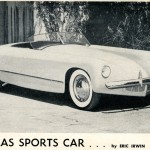
His First Lancer used a 1932 Graham Chassis, Studebaker Champion Engine, and Was Painted Ostego Blue by Hutchinson of Costa Mesa – Still Going Strong and in Business in December 2010.
So…which fiberglass car appeared first in magazines? We’ve been on the hunt to confirm this question for some time, but the verdict is now in. I thought the 1951 Glasspar G2 / Brooks Boxer would have been the candidate, but that’s not right. In fact, it was the 1951 Lancer designed and built by Bill Tritt’s friend (and co-exhibitor at the 1951 Motorama) Eric Irwin of Costa Mesa California that wins the award.
Quite a surprise to both Rick and me. And perhaps many of you too.
Motor Trend: November 1951
As mentioned above, November 1951 is when fiberglass cars debuted to the American public. In reality, these cars were completed sometime earlier with the Lancer being finished about a month earlier than the Glasspar G2 (Modern Man, November 1952 by Joseph H. Wherry). But which magazine would showcase the first article about these cars? It’s no surprise that it was Motor Trend (Petersen Publishing) who shared the first article about Eric Irwin and his Lancer in their November, 1951 issue.
The article was titled “Fiberglas Sports Car” and was written by Eric Irwin. In the article, he shared the story on how one might build the car of their dreams out of fiberglass. In fact, it was this article by Eric Irwin, and the debut of the fiberglass cars at the 1951 Petersen Motorama that Rick D’Louhy and I recognize as the “Big Bang” of fiberglass cars. All subsequent history concerning how to build your own fiberglass body and sports car starts with this article in Motor Trend, November 1951.
Highlights of the Article:

The Back of the Lancer Sloped Down As Expected, but Was Squared Off at the End. Was This the First Kamm Tailed Car Accidentally Created as a Styling Cue?
Scans of the complete article appear below for your review. However, there are several parts of the article worthy of note:
* Eric opens the article with the following words: “The conception of a dream car is pleasurable but the period of gestation is rugged, as you will discover when you sire one – and damn it too.” I love his way with language. He description of the process is vivid and quite colorful.
* In providing advice on how to avoid common body design errors, Eric shares the following: “Most dream car sketches, when scaled out, have an overall height of 31 inches and a 180 inch wheelbase.” (author’s note: 31 inches is about as high as the top of a tire and most sports cars in the 1950’s had a 100 inch wheelbase, by comparison). Eric continues, “This will provide a long, low, sleek car, but it might have some rather strange handling qualities. A body of less than tire height is easy to build, but anyone of average stature will sit so far out of the body that a windshield the size of a Macy’s window will be necessary for protection.”
* Eric continues, “I personally feel that the lines of the car may be carried back dynamically to the cockpit, retaining sufficient height to enable the use of a minimum windshield. This tends to lessen air drag by the relatively smooth airflow over a gradual hood incline, rather than having the shock effect of a large windshield.”
* Here’s a critical point made by Eric that most of the builders in the 1950’s didn’t consider: “Find out the auto licensing requirements for your state: minimum head and tail light heights, their legal position, minimum windshield heights, etc. Your state might not license the car because of some minor violation which would entail a major rework.”
Eric continues:

The Petersen Motorama Was Heavily Advertised. This Was the Second Year for the Event, and This Advertisement Appeared on the Back Cover of the November 1951 Issue of Motor Trend.
* “I recommend hiring a competent man to “lay-up” the cloth and apply the plastic. It is about a day’s job for a good lay-up man and two helpers. If you can wield a paint brush, you are the helper!”
* “Don’t use glass matt on a male mold.” Cloth is much more expensive but the time saved in grinding lumpy mat is well worth its added cost.”
* Here’s an interesting point related to our story yesterday on the “Burch Roark Special: ” The plastic is a fluid the color and consistency of clear corn syrup. Since sunlight is one of the primary curing agents, the plastic should never be applied in direct sunlight. When sufficient laminations have been laid on and saturated with the plastic, the entire unit may be placed outdoors in the sun.”
* “The cutouts to be made in the body, wheel, cockpit, head and tail lights, hood, etc are made with a hack saw; an air driven one works best. Cut all openings undersize and true them with a file.”
Eric ends his article with the following thoughts:
“That’s just about all there is to it, with the exception of the gallons of sweat, the volumes of advice on how you should have designed it, and the hours when you wonder if, after all, you are quite bright.”
An interesting article for the times in every way.
Finding Eric Irwin’s Family
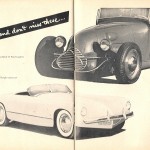
Interestingly, Only the Lancer Appeared in the 1951 Petersen Motorama Program. The Glasspar/Brooks Boxer, Wasp, and Skorpion Did Not Appear. This Page is From the Program and Shows Eric Irwin’s Lancer.
Rick and I have been searching for the full history of Eric Irwin and his cars since we started this project in 2006. In fact, the first two cars we found that sparked our full-blown interest were a 1953 Grantham Stardust and a 1952 Irwin Lancer (recently recovered from a junkyard).
Everywhere we searched, we looked for mention or information on Eric and his cars, and we found bits and pieces over the past few years. But nothing would prepare us for the e-mail and volumes of information we received on December 7th, 2010 – just a few weeks ago from Eric’s nephew Brian Jennings.
We found out the full history of Eric, his cars, and his legacy from Brian who was closest to Eric from when he was a child to when Eric passed away on April 1st, 1996 at the age of 86 years old. Although we didn’t have a chance to meet Eric, we have learned a tremendous amount of information from Brian, and look forward to sharing much of what we learned on our website and our book – including an 11 page letter written by Eric on the history of his cars and company in the 1950’s (he made many more cars than you’ll ever believe – and thanks to the generosity of Brian Jennings – we have the pictures to prove it and share his accomplishments.)
Special thanks to Brian Jennings for finding us and making available the history of his Uncle – Eric Irwin.
Summary
Rick and I have continued our search for all lost cars, including Eric Irwin’s Lancers.
The first Lancer – the one shown here in this article and that also appeared in the 1951 Petersen Motorama – has never been found. We know that Eric designed and built 3 other models of Lancers, and examples of two different models have recently been found. Rick and I are hopeful that this special Lancer – the very first one – is still out there somewhere waiting to be recovered and recognized for the true achievement it was in the early 1950’s.
After the publication of the article on how to build your own fiberglass car in the November 1951 issue of Motor Trend, no other articles about fiberglass cars appeared until February 1952 – 3 months later. By then, the cat was out of the bag and articles about the Lancer, Glasspar, and Skorpion started to appear. Soon thereafter in 1952, Victress, Atlas/Allied, Maverick, Vale, Woodill Wildfires, and other fiberglass sports cars would start to make the news and soon appear.
But the biggest splash of all was about to occur in Life magazie, February 1952. And that’s a story for a later time
Hope you enjoyed the “read” and until next time gang….
Glass on….
Geoff
——————————————————————–
Click on the Images Below to View Larger Pictures
——————————————————————-
- His First Lancer used a 1932 Graham Chassis, Studebaker Champion Engine, and Was Painted Ostego Blue by Hutchinson of Costa Mesa – Still Going Strong and in Business in December 2010.
- The Back of the Lancer Sloped Down As Expected, but Was Squared Off at the End. Was This the First Kamm Tailed Car Accidently Created as a Styling Cue?
- The Petersen Motorama Was Heavily Advertised. This Was the Second Year for the Event, and This Advertisement Appeared on the Back Cover of the November 1951 Issue of Motor Trend.
- Interestingly, Only the Lancer Appeared in the 1951 Petersen Motorama Program. The Glasspar/Brooks Boxer, Wasp, and Skorpion Did Not Appear. This Page is From the Program and Shows Eric Irwin’s Lancer.
- Here in 1951, Eric Irwin’s at the Wheel of His First Lancer – the One He Showed at the Petersen Motorama in November, 1951.

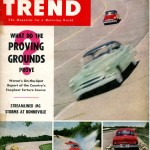

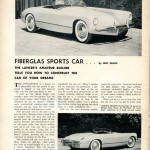
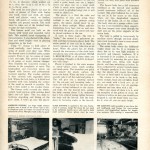
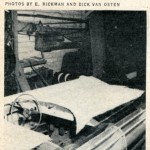



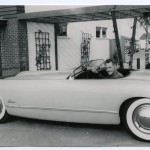
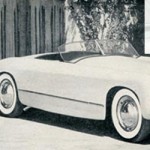
Hi,
I think I found a lost Lancer!!! Please check out the video: https://northeastwheelsevents.com/video/forgotten-fiberglass-lancer-a-fiberglass-body-kit-from-the-early
I put the link to this article with the video.
Thanks,
Pam
Hi Pam,
My apologies for taking so long to reply. These days I am working on my Lancer and have not been spending much time on the Forgotten Fiberglass/Undiscovered Classics web pages.
You have indeed found a Lancer! The last I knew, it belonged to Eddie Zimmerman and he was looking to sell it. There is more information on the UC: Lancer Sports Cars Facebook page, you just need to scroll down a bit. The not-so-recent updates for my Lancer restoration journey are there also.